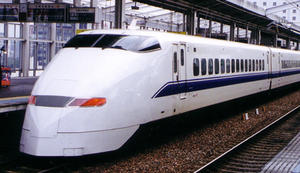Ground transportationHigh-speed derailment
Sophisticated high-speed commercial trains such as France’s TGV, Japan’s Bullet trains, and China’s Shanghai Maglev that travel up to 311 mph are leaving the United States in the dust; this week, President Obama proposed a 127 percent increase on public transit spending to create jobs and stimulate the economy despite Republican plans to reduce the $1.5 trillion deficit; Republican lawmakers, governors say the development of high-speed rail should left for the private market

High-speed rail faces an uncertain future // Source: psu.edu
Sophisticated high-speed commercial trains such as France’s TGV, Japan’s Bullet trains, and China’s Shanghai Maglev that travel up to 311 mph are leaving the United States in the dust. This week, President Obama proposed a 127 percent increase on public transit spending to create jobs and stimulate the economy despite Republican plans to reduce the $14 trillion deficit. A blow has already been dealt to Obama’s plan by Governor Rick Scott (R-Florida) who rejected the $2 billion offered to build a line between Tampa and Orlando.
Two other Republican governors have rejected federal rail funding, claiming the money could be used better elsewhere. “The truth is that this project would be far too costly to taxpayers and I believe the risk far outweighs the benefits,” Scott said in a statement.
House Budget Committee Chairman Paul Ryan (R-Wisconsin) echoed Scott’s sentiment, “We’re not a fan of high-speed rail at all.”
Obama’s budget proposal would spend $8 billion on high-speed rail projects the first year and $45 billion over the next five years. Other parts of the money would help support urban transit agencies. The American Public Transportation Association estimates that every $1 billion the government spends on public transportation returns $4 billion in new economic activity.
The House Transportation and Infrastructure Committee plans to meet Thursday 17 February 2011 to determine how the Unite States can improve the nation’s rail network. The focus will be on government-backed loans for infrastructure projects under the Railroad Rehabilitation and Improvement Financing program (RRIF), a program under which the Federal Railroad Administration administrator has the authority to provide direct loans and loan guarantees up to $35 billion.
Joyce Rose, staff director for the House Transportation and Infrastructure subcommittee on railroads said that the loans primarily fund freight rail projects, “Although they sometimes have been used by commuter railroads to buy rail cars.”
Representative Bill Shuster (R-Pennsylvania), chairman of the House Transportation and Infrastructure subcommittee on railroads, recently expressed concern the increased public transportation funding Obama proposes would not be spent effectively.
“Government won’t develop American high-speed rail,” he said. “Private investment and a competitive market will.”
Representative John Mica (R-Florida), chairman of the Transportation and Infrastructure Committee, said any additional government passenger rail funding should be focused on the Northeast Corridor, where taxpayers would get the greatest return on their investment.
The new Republican governors of Wisconsin and Ohio have rejected federal government offers of hundreds of millions of dollars for passenger rail projects in their states. They said the projects would require the state to waste money on yearly subsidies.
The Transportation Department responded by giving the money to other states, such as California, which was awarded $2.34 billion, the largest award to build a 220-mph “bullet train” to run the length of the state.
With an expected population growth of 13.5 million during the next twenty years, California would require 2,970 more miles of freeway lanes, five new runways, and ninety new airport gates for a cost of $82 billion, some estimates suggest.
Mehdi Morshed, executive director of the California High Speed Rail Authority said “It’s the boldest move I’ve seen since Eisenhower proposed the interstate highway system.”
